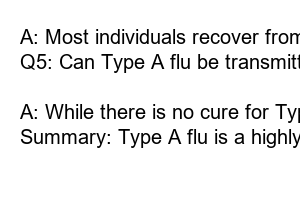A형독감
Title: Type A Flu: Symptoms, Prevention, and Treatment
Subheading 1: What is Type A Flu?
Type A flu, also known as influenza A, is a contagious respiratory illness caused by the influenza A virus. It is a common type of flu that affects humans and animals, with the potential to cause severe outbreaks and pandemics. Understanding the symptoms, prevention measures, and treatment options can help you stay informed and protect yourself and others.
Subheading 2: Symptoms of Type A Flu
The symptoms of Type A flu can vary from mild to severe and typically include fever, cough, sore throat, fatigue, body aches, and headache. Individuals infected with Type A flu may also experience sneezing, runny or stuffy nose, chills, and occasionally vomiting or diarrhea. While these symptoms are similar to those of the common cold, the flu tends to develop more abruptly and intensely.
Subheading 3: Preventing Type A Flu
Prevention is key in reducing the spread of Type A flu. Adopting healthy habits such as regularly washing hands with soap and water, using hand sanitizers, and avoiding close contact with sick individuals can help prevent transmission. Additionally, getting an annual flu vaccine is highly recommended, as it provides protection against different strains of the virus, including Type A flu.
Subheading 4: Treating Type A Flu
If you suspect you have Type A flu, it is crucial to rest and stay hydrated. Over-the-counter medications such as pain relievers and fever reducers can help alleviate symptoms. However, for severe cases or individuals at high risk of complications, antiviral medications prescribed by a healthcare professional may be necessary. These medications can shorten the duration of the illness and reduce the risk of complications.
Subheading 5: Complications of Type A Flu
Type A flu can lead to complications, particularly in individuals with weakened immune systems, young children, pregnant women, and older adults. Potential complications include pneumonia, sinus infections, ear infections, and worsening of pre-existing medical conditions. Seeking medical attention promptly is crucial if you experience difficulty breathing, persistent high fever, confusion, severe dehydration, or worsening symptoms.
Subheading 6: FAQs About Type A Flu
Q1: Can the flu vaccine prevent Type A flu?
A: Yes, the flu vaccine can provide protection against Type A flu and other strains of the virus.
Q2: Can I get Type A flu more than once?
A: Yes, it is possible to contract Type A flu multiple times, as the virus can mutate and present different strains each year.
Q3: Is Type A flu more dangerous than other types of flu?
A: While Type A flu can cause severe illness and outbreaks, the severity varies depending on the individual’s health and the strain of the virus.
Q4: How long does it take to recover from Type A flu?
A: Most individuals recover from Type A flu within a week or two, although it may take longer for certain individuals or if complications arise.
Q5: Can Type A flu be transmitted through animals?
A: Yes, some animals can carry and transmit Type A flu, highlighting the importance of practicing good hygiene around animals.
Q6: Are there any natural remedies for Type A flu?
A: While there is no cure for Type A flu, home remedies such as getting ample rest, staying hydrated, and using humidifiers can help alleviate symptoms.
Summary: Type A flu is a highly contagious respiratory illness caused by the influenza A virus. Recognizing the symptoms, adopting preventative measures, receiving an annual flu vaccine, and seeking timely medical care can help mitigate the impact of this flu. Stay informed, take care of your health, and protect those around you.

